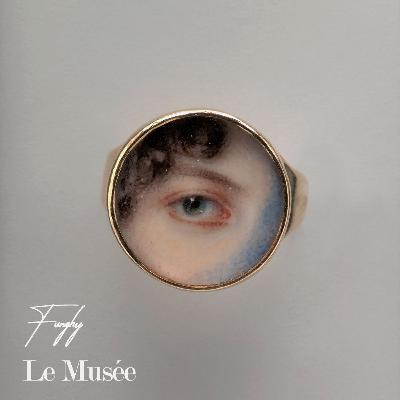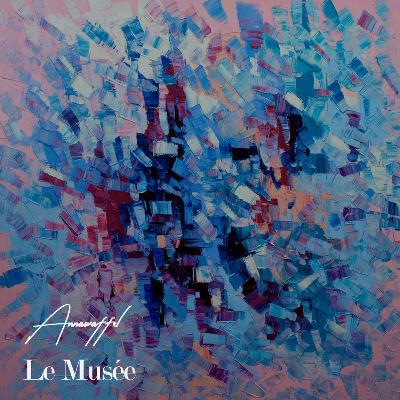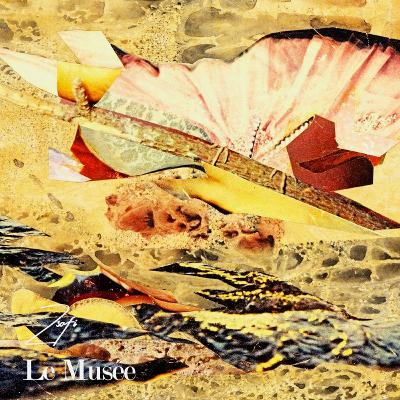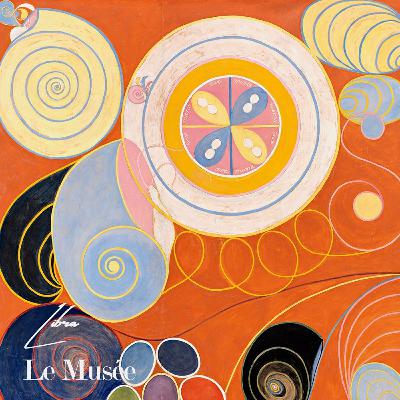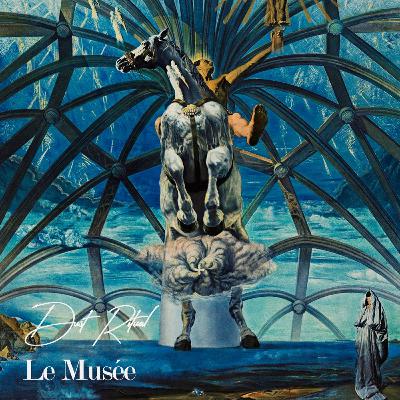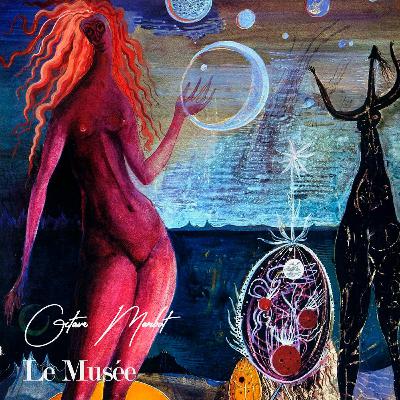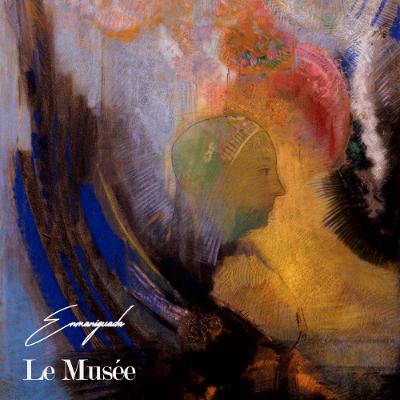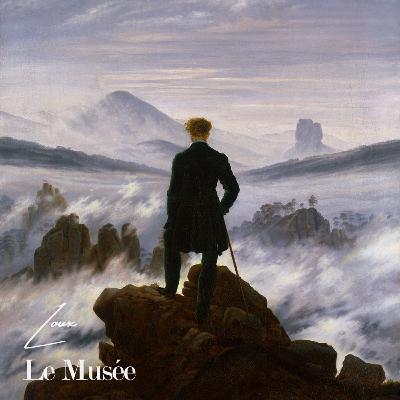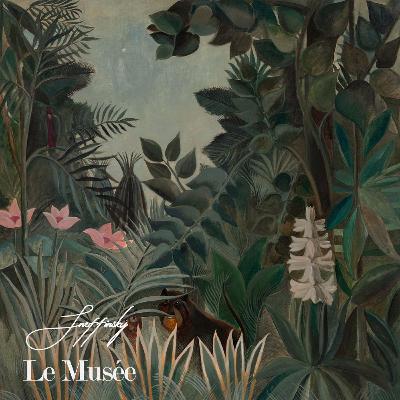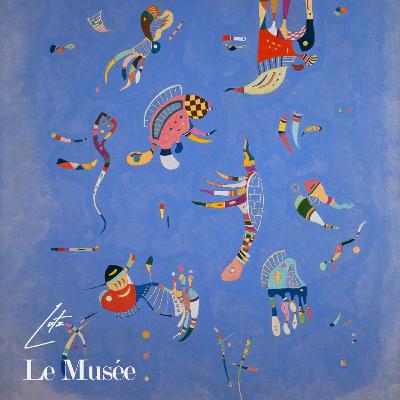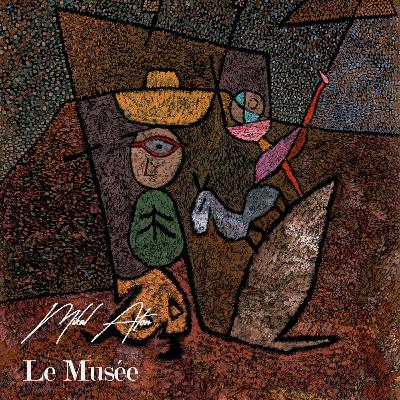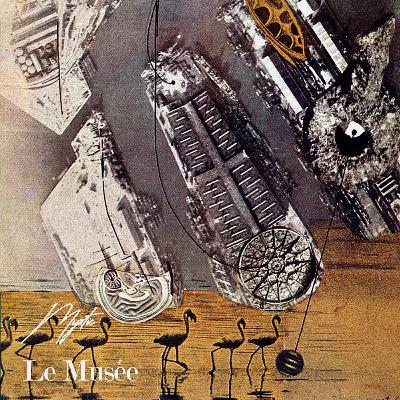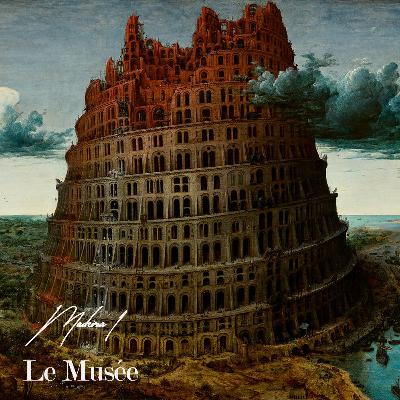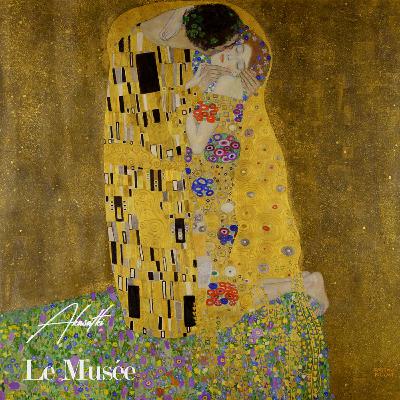Discover MuséeCast
MuséeCast

MuséeCast
Author: Le Musée
Subscribed: 0Played: 1Subscribe
Share
© All rights reserved
Description
Music like visual art is universal and can be understood across all cultures and languages. It is interwoven into our identity, being, and everyday lives. They are mediums of escapism and solace, tools of communication and reflection. like paint and canvas, sound and art are deeply connected. Even in popular culture, we consume music from a visual creative perspective.
.
Le Musée is a collective area dedicated to emerging musical compositions transformed into paintings. We want to share all types of art by collaborating with artists who create introspective sounds and mixtapes from the electronic scene.
.
If you'd like to submit a tape or a demo, DM or email to https://form.typeform.com/to/OUuKAUjF
.
Le Musée is a collective area dedicated to emerging musical compositions transformed into paintings. We want to share all types of art by collaborating with artists who create introspective sounds and mixtapes from the electronic scene.
.
If you'd like to submit a tape or a demo, DM or email to https://form.typeform.com/to/OUuKAUjF
30 Episodes
Reverse
Eye of Maria Miles Heyward by Edward Greene Malbone (1802) This delicate work belongs to the rare and intimate tradition of “lover’s eyes”, miniature portraits that depict only the eye of a loved one. This sentimental form of portraiture emerged in the late eighteenth century in England and spread to America around the turn of the nineteenth century. Such miniatures were often commissioned as tokens of affection or remembrance, set into lockets, rings, or brooches to be worn close to the heart.
Malbone’s painting isolates the right eye of Maria Miles Heyward, a member of a prominent Charleston, South Carolina, family. The subject’s identity is known through family records and later copies of the work. Malbone’s brushwork captures extraordinary subtlety for its size; the moist reflection of the eye, the finely curved lashes, and the faint tonal transitions of the surrounding skin are rendered with precise, fluid handling of watercolor on the smooth ivory surface. The translucency of the medium and the artist’s control of shadow create a striking illusion of depth and vitality despite the miniature scale.
The Metropolitan Museum’s catalog notes that this piece was once owned by Emily Drayton Taylor (1860–1952), a miniaturist and descendant of the Heyward family. Taylor is known to have made a copy of Malbone’s “Eye of Maria Miles Heyward,” suggesting that the original was preserved within the family’s collection before entering the museum. The copy remains an important record of the work’s early provenance.
Although the miniature’s current presentation is as an independent painting, its circular format corresponds to the scale and design of pieces originally intended for jewelry settings. The museum does not confirm whether the work retains its original mounting, but the dimensions and composition are consistent with examples of wearable “eye” miniatures from the same era.
Malbone’s “Eye of Maria Miles Heyward” exemplifies both his refined technique and the emotional sensitivity that distinguished his work from that of his contemporaries. The piece invites a deeply personal response: by isolating the sitter’s gaze, the artist transforms a fragment of likeness into a powerful symbol of intimacy, longing, and remembrance.
Today, this tiny portrait stands as one of the most exquisite surviving examples of the lover’s eye genre in American art and an enduring testament to Malbone’s mastery of miniature painting.
------------------------------------------------------------------
In this exclusive MuséeCast session, Funghy invites listeners into a hypnotic soundscape where rhythm becomes ritual and emotion takes shape through texture and tone. His set unfolds like a living organism, organic, unpredictable, and deeply human.
From the first pulse, Funghy builds an atmosphere of warmth and mystery, merging the tactile energy of analog sound with the introspection of electronic minimalism. Each transition feels deliberate yet instinctive, like a breath shared between movement and stillness. Layers of rhythm drift in and out of focus, revealing a dialogue between pulse and silence, light and shadow.
Follow the artist:
@erectious
https://www.instagram.com/funghyfar/
Poseidon by Ebip Serafedino (2022) Serafedino has long been recognized for a painterly language rooted in expressionism, marked by bold color, textured surfaces, and a distinctly Mediterranean vibrancy shaped by his cosmopolitan life. Having studied and worked in cities such as Rome, Florence, Venice, Berlin, and later Paris, Serafedino developed a style that avoids rigid figuration in favor of dynamic, gestural abstraction. His canvases are built upon energy, rhythm, and a tactile dialogue between form and color.
Created in 2022, Poseidon is one of the works in which Serafedino engages directly with mythology, though in his own idiom. The painting invokes the god of the sea not through narrative illustration but through atmosphere and intensity. The composition, dominated by layered textures and assertive strokes, recalls the raw, ungovernable character of the sea itself. Areas of concentrated density meet looser, more fluid gestures, producing a rhythm that can be read as a metaphor for turbulence, depth, and shifting force.
The palette reinforces this elemental presence. Instead of theatrical blues or decorative embellishment, Serafedino works with earthier, more grounded tones echoes of rock, water, shadow, and storm. This approach positions Poseidon not as a decorative mythological tableau but as a symbolic evocation of natural power. Viewers may see the painting less as a portrait of a deity than as a meditation on energy, scale, and permanence.
Serafedino’s broader practice emphasizes the physicality of painting: thick layers of pigment, worked surfaces, and an immediacy of gesture that gives his canvases a sense of both permanence and movement. In this context, Poseidon reflects his interest in reducing subjects to their essence capturing not the story of a god but the sensation of what such a figure represents. Just as his earlier works drew from the Mediterranean landscape and the vitality of color, here he channels the immensity of myth into a visual language of tension, weight, and flux.
Although Poseidon draws on an ancient theme, it is ultimately contemporary in execution. Serafedino avoids literal representation, instead offering a work that can be read as both abstract and symbolic. For some, the canvas may suggest the primal energies of the sea; for others, it may stand as a metaphor for resilience, instability, or humanity’s enduring attempt to translate nature into image. This openness to interpretation is central to Serafedino’s practice.
Through Poseidon, Serafedino demonstrates his continued ability to bridge the timeless with the modern. The painting exemplifies his expressive vocabulary dynamic brushwork, layered surfaces, and a chromatic sensibility shaped by Mediterranean fervor and Parisian refinement while at the same time inviting viewers to confront myth not as a story of the past, but as an active, living presence.
--------------------------------------------------------------------------------
For this edition of MuséeCast, Anna presents a carefully constructed DJ set that reflects both her technical precision and her thoughtful approach to musical selection. Rather than relying on spectacle, the set is defined by its coherence and steady progression, where transitions are handled with restraint and clarity.
Anna moves through her selections with a focus on atmosphere and continuity, creating a soundscape that is balanced rather than dramatic. Each track is placed with consideration, allowing the set to unfold in a way that emphasizes structure and flow over immediate impact. The result is a listening experience that invites attention to detail the textures between tracks, the subtle variations in rhythm, and the understated dialogue between sound and silence.
Follow the artist:
@anna_waffel
@doktor-waffel
@dr-uff-anna-tanke
www.instagram.com/annawaffel.bln/#
Fata Morgana is a photomontage created by Hannah Höch in 1957. Its title refers to a specific form of optical illusion: a superior mirage in which atmospheric conditions cause images to appear as floating or inverted at the horizon. The mirage phenomenon known as a fata morgana occurs when layers of warm and cool air bend light in ways that distort distant objects, making them appear elevated, mirrored, or displaced.
As a photomontage, Fata Morgana is constructed from cut and assembled photographic reproductions. In the 1950s, Höch increasingly worked with color imagery, often using printed magazines and other contemporary sources. Britannica confirms that her postwar practice moved toward more abstract compositions and the use of color fragments. The palette in Fata Morgana reflects this shift, with tonal contrasts ranging from ochre grounds to pinks and blues.
The composition demonstrates Höch’s precise control of her medium. Fragments are not simply layered but carefully positioned so that edges and forms generate a sense of rhythm and tension across the small rectangular surface. Observers have noted that the fragments can evoke natural or geological associations, but these remain open to interpretation rather than definitive representation.
Although Fata Morgana is not overtly satirical or political in the manner of Höch’s Dada works from the 1910s and 1920s, it continues her exploration of transformation, fragmentation, and perception. Art historians describe her postwar works as more meditative, often shifting the focus from direct social critique to poetic and abstract visual construction. In this sense, the title Fata Morgana may be seen as reinforcing themes of illusion and instability, though such interpretations belong to critical readings of the work rather than documented statements by the artist.
By the time she produced Fata Morgana, Höch was nearly seventy years old, yet the work reflects her ongoing experimentation with collage. Its layered fragments and evocative title align with recurring concerns in her practice: the instability of vision, the recombination of images, and the transformation of familiar materials into new and ambiguous forms.
--------------------------------------------------------------------------------
Zsófi’s latest set for MuséeCast unfolds with a sleek and hypnotic energy, moving fluidly between acid house, minimal tech, and minimal house with a distinctly European edge. Precision and restraint shape her selections: sharp basslines pulse beneath crisp, uncluttered rhythms, while subtle melodic textures rise and recede like shifting light. The result is a set that feels both raw and refined, lean and stripped back, yet full of kinetic tension. Zsófi captures the essence of underground minimalism, where every detail matters and space itself become part of the groove. Built on clarity and control, the mix emphasizes structure, pacing, and atmosphere, presenting a clear exploration of minimal electronic sound.
Follow the artist:
@zsofi_mix
https://www.instagram.com/zsofi_mix/
Hilma af Klint’s No. 3, Youth is part of The Ten Largest (1907), one of the most ambitious and groundbreaking series in early modern art. The ten paintings, each more than three meters tall, explore the four great stages of human life: childhood, youth, adulthood, and old age. Af Klint believed these stages were not only physical but also spiritual passages, shaped by forces beyond what can be seen.
In Youth, she turns the complexity of adolescence into color and form. Large spirals, ellipses, and floral patterns sweep across the canvas in constant motion, suggesting the growth, vitality, and turbulence of this period in life. The palette of glowing oranges, deep violets, and soft blues creates a sense of rhythm and energy, while fine decorative lines and details remind us of the fragility that comes with transition. Together, these forms express both the excitement and uncertainty of stepping out of childhood and into the wider world.
Af Klint’s work here is not a literal portrait of young people, but a symbolic map of development. Drawing inspiration from natural sciences, spiritual teachings, and her own visionary experiences, she created a new kind of visual language. Her aim was to capture invisible forces the flow of energy, the cycles of nature, and the unseen dimensions of human growth.
Painted in 1907, The Ten Largest predates the fully abstract works of artists like Kandinsky, Mondrian, and Malevich by several years. These vast compositions show how af Klint was working at the edge of invention, combining abstraction with ideas of evolution, spirituality, and psychology. With Youth, she offers an image of life in motion overflowing with curiosity, potential, and transformation.
Today, Youth stands as a powerful reminder of af Klint’s unique vision. It demonstrates how abstraction can move beyond decoration or style to communicate profound human experiences. By translating the inner life of adolescence into color and form, af Klint challenged the boundaries of art in her time and opened a path for future generations of artists to explore the unseen dimensions of existence.
--------------------------------------------------------------------------------
Libra delivers an Indie Dance set that highlights the genre’s balance between rhythm and atmosphere. The mix moves through steady basslines, crisp percussion, and melodic layers that give it both drive and depth. Each track is selected and blended with precision, creating a continuous flow that maintains energy without losing subtlety.
The set captures the essence of Indie Dance, with a focus on groove, mood, and texture, keeping the focus on structure and progression, while allowing space for the listener to engage fully with the sound.
This is a performance built on clarity and balance, reflecting Libra’s approach to music measured, thoughtful, and immersive.
Follow the artist:
@libra_sound
Santiago El Grande by Salvador Dalí (1957) is a masterful oil-on-canvas that stands as a resounding emblem of his “nuclear mysticism” phase. The composition features Saint James the Great, the patron saint of Spain, rearing triumphantly from the sea atop a white stallion, gripping an oversized crucifix an image both heroic and mystical. From a four-petalled jasmine flower a symbol of purity and one of Dalí’s personal favorites an atomic explosion erupts, propelling the supernatural tableau skyward, merging religious reverence with scientific wonder. Framing this ascension is a ribbed, cathedral-vault-like tracery that fans out in a celestial canopy, referencing Gothic pilgrimage architecture and specifically alluding to the Camino de Santiago and the Cathedral of Santiago de Compostela. The saint’s harness is adorned with scallop shells a nod to the pilgrimage tradition while the prominent bare foot, modeled on Dalí’s own, symbolizes the common pilgrim, Everyman, on a spiritual journey. Gazing contemplatively from the lower right is a small, veiled figure possibly the Virgin Mary or the artist’s muse, Gala adding a quiet, human presence to the dramatic scene. Further complexity emerges in the partial transparency of some figures, the foreshortened forms that enhance three dimensionality, and subtle details like angels embedded within the horse’s anatomy. Originally intended for the Spanish pavilion at the 1958 Brussels World’s Fair (and perhaps as an altarpiece for the Escorial), the painting was ultimately acquired by Lady Dunn and donated to the Beaverbrook Art Gallery in Fredericton, New Brunswick. Its inaugural public exhibition took place in New York in 1958 at M. Knoedler & Co., and it later featured in the “Salvador Dalí: The Late Work” exhibition at Atlanta's High Museum of Art in 2010–11.
This rich fusion of devotional imagery, geometric form, personal symbolism, and atomic-age sensibility cements Santiago El Grande as one of Dalí’s most profound and visually arresting statements where the sacred, the scientific, and the surreal all converge in a dramatic, transcendent vision.
--------------------------------------------------------------------------------
I’m excited to share something special on MuséeCast an extended 4-hour set from Dust Ritual, the creator of the podcast. Known for building long, evolving journeys through sound, this set dives deeper than ever, unfolding layer by layer with shifting moods, subtle textures, and moments that draw you in and hold you there. Over the course of four hours, I let the music breathe and expand, creating space for both quiet reflection and powerful release. For me, it’s more than just a set it’s a narrative in sound, a reminder of why I started MuséeCast in the first place: to explore music not as background, but as an experience, something lived and shared. Some journeys are meant to be walked alone, others in silence, but this one carries echoes of a companion who’s been with me all along. Happy Friday :)
Follow the artist:
@dustritual
Carnation, Lily, Lily, Rose (1885–1886) by John Singer Sargent is a captivating vision of twilight a poem in paint where innocence, light, and time converge. Set in the garden of Farnham House in Broadway, in England’s Cotswolds, Sargent began the work during the summer of 1885, not long after departing Paris in the wake of the “Madame X” controversy. The idea was sparked during a September boating trip on the Thames at Pangbourne, where he saw Chinese lanterns glowing among trees and lilies at dusk. The painting depicts two young girls Dolly to the left and Polly to the right lighting paper lanterns amid roses, carnations, and tall white lilies in bloom. Originally, Sargent had planned to use the dark-haired daughter of his friend Frederick Barnard as a model, but she was replaced by the Barnard sisters for their fair hair, which better suited the luminous palette. Painted en plein air with impressionistic spontaneity, Sargent worked each evening for just a few precious minutes during the fleeting “blue hour” to capture the delicate balance between lantern glow and fading daylight. As real flowers wilted with the advancing season, he replaced them with artificial ones to preserve the harmony of the composition. The canvas was originally rectangular but later trimmed by about two feet on the left to emphasize the central figures and bring it closer to a square format. When it was unveiled at the Royal Academy’s Summer Exhibition in 1887, it received both criticism for its “Frenchified” style and praise from admirers, including Sir Frederic Leighton, who encouraged its acquisition for the nation. It became the first of Sargent’s works to enter a British public collection, and today it resides in Tate Britain. The scene captures the quiet enchantment of evening the hush of a garden, the gleam of lanterns, the fragrance of blooms distilled into a single suspended breath where the ephemeral beauty of nature and the artistry of light merge into something timeless.
--------------------------------------------------------------------------------
In this MuséeCast session, Jonas Studer, performing as Badawan, delivers a set that bends genres and redefines the dancefloor’s edge. Moving between deep, psychedelic textures, hypnotic midtempo grooves, and driving rhythmic progressions, he shapes a sound that feels both raw and deliberate. There’s a storyteller’s pulse to the way he shifts from shadowy, progressive passages into bright, kaleidoscopic moments each change carrying its own sense of momentum. With roots firmly planted in underground culture, his music carries an untamed energy, rich in detail and layered with atmospheric depth. This is Badawan at his most fluid and focused, blending instinct and precision into a performance that stays with you long after the last beat fades.
Follow the artist:
@yunus-studer
https://www.instagram.com/jonas_studer/?hl=de
Eight World – Lament Over the Cosmic Egg by Ernst Fuchs (1947) one of the earliest significant works by Austrian painter Ernst. Only 17 years old at the time, Fuchs had recently enrolled at the Academy of Fine Arts in Vienna, where he was studying under Professor Albert Paris Gütersloh. The painting reflects a remarkable level of technical skill and philosophical depth for such a young artist, offering a glimpse into the symbolic and spiritual vision that would later define Fuchs' mature style.
Rendered in a mixed technique of tempera and oil glaze on wood, this work exemplifies the early stylistic foundation of what would later become known as the Vienna School of Fantastic Realism a post-war artistic movement cofounded by Fuchs in the 1950s alongside artists such as Arik Brauer, Wolfgang Hutter, Rudolf Hausner, and Anton Lehmden. This group sought to combine the classical painting techniques of the Old Masters with surreal and symbolic imagery that explored dreams, metaphysics, and the unconscious.
The composition of Eight World – Lament Over the Cosmic Egg is visually structured and allegorically rich. It is centered around the image of a cosmic egg, a symbol found in many ancient mythologies representing the origin of the universe, the birth of life, or the fusion of matter and spirit. In this painting, the egg appears as a glowing central form, flanked symmetrically by two elongated, ethereal female figures, whose posture and expressions contribute to an atmosphere of solemnity and mystery. The background is divided into three horizontal zones: a dark, watery lower realm; a middle space filled with abstract, flesh-like or geometric forms; and a luminous upper sky, possibly signifying a spiritual or transcendent plane.
The painting’s meticulous glazing technique, inherited from Flemish and Renaissance traditions, creates a jewel-like surface that enhances the dreamlike quality of the image. Fuchs was known for reviving and mastering these older methods to heighten the spiritual intensity of his subjects. His early fascination with sacred art, biblical themes, and medieval iconography is already evident here, woven into an original visual language that would later be recognized as central to his oeuvre.
Fuchs’ lifelong engagement with spiritual philosophy, esotericism, and sacred geometry would later become central to his vast body of work, including paintings, stained glass, architectural design, and religious sculpture. Eight World – Lament Over the Cosmic Egg is thus not only a powerful standalone piece but also a formative step in a career devoted to the mystical possibilities of art.
Fuchs continued to develop this visionary aesthetic throughout the 20th century, eventually gaining international acclaim. He died in 2015 in Vienna, leaving behind a legacy that fused classical craftsmanship with surreal imagination and spiritual inquiry.
--------------------------------------------------------------------------------
For this special MuséeCast session, Octave Marbot the DJ and producer from Kaiserslautern (hertzmusic) takes on the role of your trusted tripsitter through the electronic underground. Since 1999, he has been navigating the audio galaxies to bring the sound of the universe to the dancefloor. With a deep-rooted passion for transcendental frequencies, Marbot crafts an experience that is more than just a set; it is a guided journey through states of mind and space.
Drawing from mystical and psychedelic sounds sourced from all corners of the world and beyond his set fuses hypnotic basslines, percussive grooves, spacey synth riffs, and a subtle infusion of acid and trance. The result is an atmospheric ascent into cosmic spheres, where sound becomes light and rhythm becomes gravity. Just as the energy peaks, he gently brings the listener back down, landing softly on the edge of the inner world.
Follow the artist:
@octavemarbot
https://www.instagram.com/octavemarbot/
In Buste ailé en profil (Sphinx), created around 1898, Odilon Redon presents one of his most enigmatic and lyrical visions: a winged female bust depicted in profile, her gaze turned inward, suspended in a softly diffused, otherworldly space. Executed in pastel, the medium Redon came to favor in his mature years, the work reflects a masterful control of color, texture, and emotional resonance. The female figure is at once ethereal and monumental, a serene presence embodying both human grace and mythological mystery. Her wings are rendered with delicate transparency, evoking angelic or dreamlike qualities rather than physical force. The background, a luminous blend of warm and cool tones, enhances the sense of timelessness and detachment from earthly concerns.
This sphinx-like figure continues Redon’s deep engagement with the Symbolist ethos, which prioritized the inner, spiritual reality over literal or narrative depiction. The work invites contemplation rather than explanation. Instead of portraying a literal mythological sphinx, Redon abstracts the motif into an allegorical presence. The being hovers between states of animal and human, seen and imagined, ancient and eternal. The use of profile suggests classical portraiture or funerary sculpture, yet the soft rendering dissolves these references into reverie.
Created at a pivotal moment in Redon’s career, when he had moved beyond his earlier charcoal drawings and lithographs into the luminous world of color, Buste ailé en profil reveals his mature Symbolist vision. It reflects not only a shift in medium but also a transformation in mood and subject matter. Color becomes a spiritual force, gently illuminating the figure without fully defining it, allowing ambiguity and emotion to dominate.
The subject also reflects Redon’s enduring interest in mythology, mysticism, and the subconscious. By removing narrative cues and placing the figure in an undefined space, he encourages the viewer to engage in a quiet, introspective dialogue. The sphinx, traditionally a bearer of riddles and secrets, is reimagined here as a symbol of inward vision and poetic mystery.
--------------------------------------------------------------------------------
In this exclusive set for MuséeCast, Enmaniguada crafts a deeply transportive auditory journey that blends ritual, memory, and layered rhythm. Rooted in the spiritual while embracing experimental electronic textures, the set unfolds like a ceremonial offering—meditative, physical, and fiercely alive.
Enmaniguada constructs a sound world that resists linear time. Pulses rise and fall like breath, inviting listeners into a trance-like space where ancestral knowledge collides with speculative futures. There is a tactile quality to her mixing: textures crackle and shimmer, low frequencies stir like distant thunder, and melodic fragments emerge like fading dreams before dissolving into silence.
Follow the artist:
@enmaniguada
www.instagram.com/enmaniguada/
Caspar David Friedrich’s Wanderer above the Sea of Fog (c. 1818) remains one of the most recognized images of German Romanticism. The painting shows a lone figure standing on a rocky peak, his back to the viewer, overlooking a fog-shrouded mountain landscape. The scene does not illustrate a specific myth or narrative. Instead, it presents a silent moment of reflection, rich with symbolic and psychological meaning.
The central figure dressed in dark attire and holding a walking stick appears calm and composed, yet his placement at the edge of the precipice suggests both authority and uncertainty. With his face turned away, the figure does not guide the viewer but instead becomes a proxy, inviting us to share his perspective.
Friedrich’s technique emphasizes contrast. The rocks in the foreground are rendered with sharp clarity, anchoring the viewer’s gaze. Behind, the fog obscures the terrain, blurring forms and creating an undefined depth. This visual tension between precision and ambiguity gives the painting its enduring impact.
The Rückenfigur motif a figure viewed from behind was one of Friedrich’s key compositional tools. It opens a contemplative space, encouraging viewers to look outward and inward simultaneously. Rather than offer narrative content, the painting functions as a metaphor for introspection and the limits of perception.
Created during a period of significant philosophical and cultural change in Europe, the work reflects contemporary concerns about the individual’s relationship with nature, knowledge, and the unknown. Unlike traditional landscapes that framed nature as a backdrop, Friedrich presented it as sublime, overwhelming, and ultimately unknowable. The fog here is not just meteorological it stands for mystery and the vastness of what lies beyond human understanding.
-----------------------------------------------------------------
On this episode of MuséeCast, Loux delivers a refined and introspective set that explores rhythmic minimalism and tonal layering. Prioritizing space and subtle development, the mix draws from deep house, minimal, and experimental electronic music, offering a sustained and cohesive listening experience.
The set opens with sparse percussive patterns and gradually builds complexity without abrupt shifts. Each track is allowed to evolve naturally, contributing to a flow marked by restraint and clarity. Rather than relying on overt peaks, Loux structures the episode through gradual shifts in rhythm and texture.
Transitions are seamless yet unobtrusive. The sound palette remains consistent, emphasizing immersion over contrast. There is minimal use of vocals, which allows the rhythmic and tonal elements to remain in focus. The overall experience favors atmosphere and long-form listening over dramatic structure.
This episode aligns with Le Musée Podcast’s curatorial aim of exploring sound as an emotional and spatial medium. Loux offers a set that bridges contemplative soundscapes and club sensibility—quietly structured, thoughtfully paced, and open to interpretation.
Follow the artist:
SoundCloud: @l-o-u-x
Telegram: https://t.me/+4AMT_6cDn_E5ZTQ8
Tracklist:
1. Chiller - I'm Mady
2. Nåmi Nåmi (Trippin Jaguar Remix) – Antaares
3. Alma Perdida – Erhan Yilmaz
4. Gond Song – Mahumen
5. Aum – ₦ł₭Ʉ
6. Chameleon – Cereus
7. Something Ancient – gingembre
8. Napauken Feat. Fruiterama – Shkoon
9. Alfred's Light – Sangeet
10. Escape Into REM Sleep – Jonas Fasching
11. Asado Western – Geplantes Nichtstun & Fai Baba
12. Simple Tasks – gingembre
13. Spring and Neap – Nyvs
14. Gardens Of Wonders – Xande
15. Here is Fine (Gingembre & K.C.M. Remix) – Lou Ismaēl
16. White Smoke – apaj
Sonata No. 7 (Sonata of the Pyramids), Allegro – Mikalojus Konstantinas Čiurlionis, 1909 is a remarkable synthesis of sound and symbol. Known for his unique fusion of music, painting, and metaphysical thought, Čiurlionis approached composition not merely as a craft but as a form of cosmic inquiry. The Allegro movement of this sonata is particularly striking—a dynamic and enigmatic meditation that blurs the lines between architecture and music, myth and memory, matter and spirit.
The piece opens with a sense of purposeful ascent, as if the music itself were rising from the sands, echoing the geometry and silent grandeur of the pyramids. Its motifs are not ornamental—they are elemental. With each phrase, Čiurlionis chisels sound like stone, layering rhythms and harmonies that feel less performed than revealed. There’s an ancient dignity to the movement, a sense that it listens inwardly even as it moves forward, as if guided by an invisible compass tuned to celestial alignment.
Yet this is not a historical pastiche or a romantic fantasy. Instead, the Allegro explores the psychological and symbolic weight of the pyramid: a structure that embodies human aspiration toward the eternal. In this sonata, the pyramid becomes less a monument and more a metaphor—of stillness in motion, of order within chaos, of ascent through discipline. Čiurlionis’s music doesn’t attempt to narrate the myths of Egypt; rather, it channels the spiritual awe those monuments provoke.
As the movement unfolds, themes emerge and vanish like shifting desert winds, echoing the impermanence of life against the illusion of permanence. There’s something deeply introspective here—a quiet invitation to contemplate not just history, but our own interior architecture. What pyramids have we built within ourselves? What forgotten echoes still hum within the chambers of the soul?
In Sonata of the Pyramids, Čiurlionis offers no easy resolution. Instead, he leaves us suspended in luminous tension—a state of alert silence where thought becomes form and form dissolves into mystery. The Allegro is not just a movement of music; it is a movement of the mind, and of the spirit, toward something greater than itself.
It is a reminder that the deepest structures are not made of stone, but of sound, intention, and stillness.
--------------------------------------------------------------------------------
This one’s a slow burner. AleAle brings a patient, textured set that doesn’t try to impress you from the start — and that’s the beauty of it. It leans into mood over momentum, gradually pulling you into a space where rhythms breathe and transitions stretch. The sound palette is warm and understated, with careful attention to detail rather than big peaks or flashy drops.
It’s the kind of set that rewards listening all the way through — not for big moments, but for how it holds together as a whole. Definitely one to put on when you’re in the mood to drift, focus, or just let time slow down a little.
Follow the artist:
@aleale32
www.facebook.com/aleale32
www.instagram.com/ale.cap32/#
Henri Rousseau’s The Equatorial Jungle (1909) represents one of the most ambitious and mature works of the self-taught French painter, encapsulating the distinctive visual language that has come to define his contribution to modern art. Created near the end of Rousseau’s life, the painting offers a striking vision of a dense, otherworldly rainforest rendered with a heightened sense of stylization, symbolic intent, and compositional control. Although Rousseau never visited a tropical region, his jungles—constructed entirely from imagination and secondary sources—exemplify his ability to synthesize disparate influences into a cohesive and psychologically resonant pictorial universe.
The composition is dominated by an overwhelming profusion of foliage, meticulously arranged to create a layered and immersive environment. Rousseau fills the canvas with a dense wall of vegetation: oversized palm fronds, creeping vines, and exaggerated leaf forms interweave in complex, rhythmic patterns. This tightly controlled repetition and flat, decorative surface contribute to the dreamlike quality of the work, where natural forms are stylized rather than observed. The use of vibrant greens, punctuated by occasional bursts of floral color or animal presence, creates a visual field that is at once lush, claustrophobic, and hypnotically ordered.
Populating this imaginary ecosystem are a variety of tropical animals—birds, snakes, monkeys, and other elusive creatures—that appear partly camouflaged and partly emblematic. These figures are rendered with a childlike clarity and simplicity that belies the sophistication of their placement within the composition. Rousseau’s fauna do not interact dynamically with their environment; rather, they occupy it with a kind of still, symbolic presence, lending the scene a sense of calm introspection rather than narrative drama. This static quality is further reinforced by Rousseau’s use of flat color fields and his deliberate avoidance of conventional perspective and modeling.
Despite its apparent naïveté, The Equatorial Jungle is underpinned by a deep conceptual and formal intelligence. Rousseau constructed his jungle scenes by studying plants in the Jardin des Plantes in Paris, examining natural history books, and incorporating visual material from colonial exhibitions. Yet, rather than attempting naturalistic fidelity, he transformed these elements into a cohesive vision rooted in fantasy and the subconscious. The result is not a realistic depiction of a jungle but a psychological landscape—an imagined space of mystery, reverie, and primal stillness.
--------------------------------------------------------------------------------
For this episode of MuséeCast, we welcome Berlin-based artist Sneffinsky, who delivers a deeply emotive and progressive downtempo set—a reflective journey through sound shaped by recent personal shifts and collective transitions. Drawing from powerful and resonant textures, Sneffinsky guides listeners through a contemplative sonic landscape that moves from shadow into light.
Here are a few words from the artist:
hola familia,
i am very delighted & grateful to provide a compilation of some powerful, deep & progressive downtempo music that resonated a lot with me lately.
while recording this mix, i felt that there have been quite some strong energies moving all around me. it’s like something big is shifting. and even though this shift is not of an easy-going kind, i can feel that it is moving us all closer towards the light. the brighter days are slowly taking over again. at the end of any dark period there is light again, like in a tunnel - the only way out is to go through.
et voilà, here we are - welcome to a new wonderful chapter. let yourself go and be guided through this deep sonic journey.
with love & gratitude
saymon aka. sneffinsky ꩜
Follow The Artist:
SC: soundcloud.com/sneffinsky
IG:www.instagram.com/sneffinsky/
Paul Klee "Fish Magic" (1925) unfolds like a dream half-remembered at dawn, its surface a dark mirror through which hidden realms beckon. At first, we see only the shadowy expanse—inky black, as if Klee has summoned night itself onto canvas. But beneath this nocturnal cloak, scratched-away slivers reveal a secret spectrum of color: pale blues and pinks, sunlit golds and ghostly greens, whispering of life just beneath the hushed surface.
Peering closer, the fish emerge as silent confidants, their forms ethereal and weightless. They drift through this suspended hush, their scales catching the faint glow of colors that seem to pulse with memory. Each fish becomes a symbol of the self, gliding between what we show and what we conceal, reminding us that our most vivid truths often swim beneath layers of restraint.
Around them, delicate blossoms and petals float as if untethered by gravity. They mingle with fragments of musical notation and grids of ink, suggesting that art, thought, and emotion are not separate—each one sings within the same submerged chorus. The solitary clock face, its hands frozen, hints at time’s fragile sovereignty: here, past and future collapse into a single moment of quiet revelation.
Standing before Fish Magic, we are invited to become explorers of our own inner ocean. What rhythms beneath our calm exterior dictate our impulses? Which memories lie buried in the trenches of our mind, awaiting discovery? Klee’s work does not merely depict a scene—it creates a space for introspection, urging us to acknowledge the fluidity of identity, the interplay of light and shadow in our psyche.
In this suspended world, we sense both wonder and unease. It is a place where logic loosens its grip and intuition takes the helm. And as we lose ourselves in its depths, we may find that the true magic is not in the painting alone, but in the revelations it provokes within us.
--------------------------------------------------------------------------------
In this episode of MuséeCast, Fabioli flying solo—no Pascal tag‑along this time—bringing a fresh, unfiltered sound straight from Fabian’s decks to your speakers. Known for weaving deep grooves with unexpected twists, Fabioli delivers a journey that moves fluidly between sun‑soaked warmth and nocturnal allure. Whether you’ve followed the duo’s Papaya Project or are just discovering Fabioli’s singular voice, this set promises moments of introspection, dance‑floor euphoria, and sonic exploration.
Follow the artist:
SC: https://soundcloud.com/fabioli-papaya
IG: https://www.instagram.com/fabioli_dj/
Sky Blue (1940) by Wassily Kandinsky was painted towards the end of Kandinsky's career. It appears as blue patch of what resembles sky, bordered by a slightly lighter blue tone representing clouds. a world that feels like a dream. The sky is a wide, open space filled with floating shapes and playful creatures. They drift peacefully, as if weightless, moving through the blue like thoughts floating in the mind.
Each figure is unique—some stretch out as if flying, while others curl up as if resting. Their bright colors and soft lines make them look like they belong to a story only the sky can tell. It’s as if each one has its own secret, yet they all fit together in perfect harmony.
The painting feels calm and free, like the world has paused just for a moment. It invites you to imagine what it would be like to float without worry, to explore the endless sky without limits. Kandinsky seems to paint not just what he sees, but what he feels—a place where dreams and colors come alive. it’s a window to a peaceful, endless world where imagination can fly.
————————————————————
In the intricate world of electronic music, LVTZ crafts a sonic experience that feels both expansive and intimate—a delicate balance between pulsating rhythms and meditative stillness. His sets are journeys that defy the boundaries of time, inviting listeners to step away from the ordinary and drift into a landscape of sound where emotion and rhythm intertwine.
With an ear for depth and a heart for storytelling, LVTZ curates tracks that aren’t just heard but felt—each beat a brushstroke on the canvas of the mind. Through Le Musée Podcast, he shares these musical stories, offering a glimpse into a world where music transcends mere sound and becomes an experience of introspection and connection.
"El Toisón de Oro" by Wolfgang Paalen (1937) a painting whispers a conversation between the subconscious and the visible world.
At first glance, the work feels like a dense, mysterious ritual, a dream where forms flicker between meaning and unmeaning. Paalen was not painting objects; he was painting states of existence — internal landscapes where logic dissolves and instinct speaks.
The title, El Toisón de Oro (The Golden Fleece), recalls the ancient myth of Jason and the Argonauts, where the golden fleece symbolizes ultimate achievement, heroic destiny, or spiritual enlightenment. But in Paalen's vision, the fleece is not a shining prize on a pedestal; it is buried, fragmented, perhaps even forgotten. In this inversion, the painting tells a different, more haunting story about the human mind: the quest for meaning is not linear — it is chaotic, painful, filled with illusions and half-seen truths.
The swirling organic textures, the way forms seem to melt into and out of each other, suggest a world where nothing is fully separate — an echo of the human psyche itself. Memories, desires, fears, myths: all overlap and clash within us. The brain does not neatly organize life; it collides it, blends it, shatters it into dreams.
In this sense, El Toisón de Oro becomes a mirror.
It asks:
— What is it that we are really seeking?
— Is it glory? Redemption? The truth about ourselves?
— Or are we simply chasing after symbols, golden illusions, stitched from our own hunger?
Paalen’s work whispers that the golden fleece we search for may not be out there in the world at all.
It might be the fragile, elusive understanding of who we are — a thing never fully grasped, always transforming.
-------------------------------------------------------------------------------
Siru is a Berlin-based DJ who has found his love in the sounds of bassy, sonorous and melodic songs. His credo is
With this he wants to express that everyone should listen to and follow their own rhythm and that his music should tell the listener a musical story in which they can surrender to the flow of their thoughts. In each set he tries to give his musical direction a different touch.
Follow the artist:
@siru_music
https://www.instagram.com/siru_music/
"The Traveling Circus" by Paul Klee, painted in 1926, captivates with its whimsical yet introspective composition. Klee, known for his abstract and playful style, creates a carnival-like atmosphere on canvas. At first glance, vibrant colors and bold shapes dominate, drawing viewers into a bustling scene where figures and forms seem to dance and mingle.
The painting unfolds like a narrative, each element contributing to a sense of movement and spontaneity. Klee's use of geometric forms and intersecting lines suggests a dynamic energy, as if the circus is in perpetual motion. Amidst the chaos, there's a harmony found in the balance of colors—warm oranges and yellows contrast with cool blues and greens, creating a visual rhythm that echoes the liveliness of the circus.
Central to the composition are the abstracted figures: acrobats, clowns, and animals rendered in Klee's distinctive style. These figures are not just performers but symbols of human expression and emotion. They embody a sense of playfulness and wonder, yet beneath the surface, there's a deeper contemplation on the fleeting nature of joy and performance.
Klee's mastery lies in his ability to evoke multiple layers of meaning through simplicity and abstraction. "The Traveling Circus" invites viewers to partake in its spectacle while prompting introspection on the transient nature of happiness and the enduring allure of artistic expression. It stands as a testament to Klee's belief that art should not merely replicate reality but should ignite imagination and provoke thought, leaving a lasting impression on those who engage with it.
---------------------------------------------------------------
In the heart of the Le Musée, where sound becomes a canvas for the storytellers, Mikal Aton orchestrates a set that unfolds like a journey through vibrant landscapes of emotion. Each track is a brushstroke, painting the air with hues of deep blues that evoke midnight reveries and fiery oranges that mirror a desert sunset. The rhythm, like a steady heartbeat, guides listeners through a narrative labyrinth where melodies whisper secrets and basslines pulse with anticipation.
Recorded live at the intimate Small Flow Club in Berlin, this set captures the raw and immediate energy of the night. Imagine a tapestry woven from the threads of sound—soft whispers that carry tales of distant lands and crescendos that build like towering cathedrals of sound. Mikal Aton's set is a symphony of contrasts: smooth like satin in one moment, then jagged like shards of glass in the next. It's a tale of light and shadow, where every beat is a heartbeat and every pause a breath held in anticipation.
Close your eyes and let the music transport you. Feel the warmth of amber tones embracing you, the cool touch of azure rhythms cascading over your senses. In this sonic odyssey, Mikal Aton invites you to explore the unseen corners of your imagination, where each note is a brushstroke in the masterpiece of your own journey.
Follow the artist:
@mikalaton
@a_t_o_n
www.instagram.com/mikalaton/
Max Ernst's painting "Cormorants" from 1920 is an example of his early surrealist work. Ernst, a key figure in the Dada and Surrealist movements, often incorporated dream-like and fantastical elements in his art. "Cormorants" is notable for its enigmatic and abstract style, characteristic of his works during this period.
The painting features a series of dark, bird-like forms resembling cormorants, set against a backdrop that blends natural and surreal elements. Ernst's technique often involved using frottage (rubbing pencil or other medium over a textured surface) and grattage (scraping off layers of paint), which added a textured, layered quality to his work. These methods allowed him to explore subconscious imagery and spontaneous creation, central themes in Surrealism.
In "Cormorants," the birds are depicted in a manner that blurs the line between reality and imagination, with exaggerated forms and surreal surroundings. This piece reflects Ernst's fascination with the mysterious and the unknown, inviting viewers to delve into a world where ordinary subjects are transformed into strange and evocative images. The painting captures a sense of movement and fluidity, suggesting the birds' interaction with an unseen force or environment.
Ernst's work, including "Cormorants," had a significant impact on the development of Surrealist art. His innovative techniques and visionary approach influenced many artists and helped to define the movement's visual language. "Cormorants" stands as a testament to his ability to merge natural elements with the fantastical, creating a unique and compelling artistic expression.
--------------------------------------------------------------------
Step into a realm where music transcends the ordinary, where each note whispers secrets of the cosmos and every melody weaves tales of the unseen. Mystic invites you to experience an immersive exploration of sound and soul.
As you press play, let the ethereal harmonies guide you through a journey of introspection. Feel the rhythms resonating with the deepest parts of your being, evoking emotions long forgotten and dreams yet to be realized. This mixtape is not just a collection of songs; it is a portal to the mystical, a bridge between the conscious mind and the vast expanse of the subconscious.
Close your eyes and allow the music to envelop you. In this meditative state, you may find yourself wandering through ancient forests, floating amidst the stars, or diving into the depths of the ocean. Each track is a story, a fragment of a larger narrative that invites you to ponder the mysteries of existence and the interconnectedness of all things.
This is an invitation to pause and reflect, to listen with an open heart and an open mind. It is a reminder that in the hustle and bustle of daily life, there exists a quiet space within us all, a sanctuary where we can reconnect with our inner selves and the universe around us.
Follow the artist:
@forestmystic
Pieter Bruegel the Elder's "The Tower of Babel" is a masterful 1563 painting that captures the ambitious yet doomed biblical construction. Bruegel, renowned for his intricate detail and panoramic landscapes, presents the Tower as a colossal, spiraling structure, dominating the scene with its grand yet incomplete form. The painting reflects the biblical narrative where humanity's pride led them to build a tower reaching the heavens, resulting in divine intervention that confused their languages and halted their progress.
The Tower itself, inspired by Roman architecture, resembles a giant ziggurat, with layers upon layers of arches and scaffolding. Workers swarm over the construction, symbolizing human endeavor and the complexity of the task. The surrounding city and landscape, rendered in Bruegel's signature style, highlight the contrast between human ambition and the vast, immutable natural world.
In the foreground, Nimrod, the mighty ruler, oversees the project, emphasizing the theme of power and its limitations. The painting's meticulous detail invites viewers to ponder each element, from the workers' toil to the architectural intricacies, creating a rich tapestry of human aspiration and divine consequence.
Bruegel's "The Tower of Babel" serves as a timeless commentary on the hubris of humanity and the inevitable downfall of overreaching ambition. It remains a poignant reminder of the limits of human achievement and the enduring power of nature and divine will.
----------------------------------------------------------------------------
Once upon a summer night in the shadow of a towering monument, where the wind whispers secrets around its ancient stones, Le Musée found a symphony within the solitude. Our latest creation by Madeira 1, is not just music—it's a journey through the soul of a towering edifice, an introspective dance with history, and a dialogue between past and present.
Imagine standing at the top of the tower, the city below, the stars above, and the distant echo of ancient melodies carried by the wind. Each track is crafted to evoke that very essence. It's a mixtape for dreamers and wanderers, for those who find beauty in introspection and solace in the historical grandeur.
We invite you to let Madeira 1 be your guide through an auditory landscape where tradition meets innovation. Close your eyes, feel the timeless air, and let the music transport you to a place where time stands still and every note tells a story. 🌿✨
.
.
Follow the artist > @user-861950264
Fernando Botero, the Colombian artist renowned for his distinctive style, has captivated audiences worldwide with his unique interpretation of the human figure. His paintings and sculptures are characterized by their exaggerated proportions, rounded forms, and a sense of whimsy that belies deeper themes.
In his work "Contorsionista" from 2007, Botero likely continues his exploration of the human form, this time focusing on the contortionist—a figure whose very existence challenges the limits of the body's flexibility and endurance. Through his exaggerated style, Botero may have imbued the contortionist with a sense of larger-than-life presence, emphasizing the physical and emotional strain of such contorted poses.
Botero's fascination with distortion goes beyond mere caricature; it delves into the essence of the human condition, inviting viewers to reflect on the complexities of existence. By amplifying the proportions of his subjects, he highlights the inherent drama and tension within everyday scenes, elevating the mundane to the realm of the extraordinary.
"Contorsionista" likely serves as a testament to Botero's mastery of form and his ability to infuse his subjects with a profound sense of humanity. The contortionist, with his exaggerated curves and contorted limbs, becomes a symbol of resilience and determination in the face of adversity—a reminder of the extraordinary capabilities latent within the human spirit.
Through his art, Botero invites us to reconsider our perceptions of beauty, strength, and vulnerability. "Contorsionista" is not merely a portrayal of a circus performer; it is a meditation on the human experience itself—a celebration of the human spirit over the constraints of the physical body.
--------------------------------------------------------------------
In the mystical realm of Le Musée, where whispers of ancient canvas mingle with the melodies of the present, Jennyloco invites you to embark on a journey beyond the boundaries of time and space.
Close your eyes and let the ethereal strains of her set wash over you like a gentle breeze, stirring the depths of your soul with each carefully crafted beat. As the music unfolds, so too does the spirit of the paintings that adorn the walls of the imaginary gallery, each stroke of color pulsating with newfound life.
Through the alchemy of sound and vision, Jennyloco unveils the secret connection between music and paintings, where harmonies become brushstrokes and rhythms morph into swirling landscapes. With each chord, a new scene unfolds before your mind's eye, a kaleidoscope of emotions and imagery that transcends the limitations of the physical world.
Join us as we journey deeper into the labyrinth of creativity, where art begets art in an endless cycle of inspiration and expression. Together, let us celebrate the boundless power of the human imagination and reveal the magic of music and paintings united as one!
Follow the artists:
@jennyloco
www.instagram.com/jennylocodj
"The Song of Love" is a remarkable painting by Italian artist Giorgio de Chirico, created in 1914 during his metaphysical art phase. This masterpiece epitomizes the eerie and enigmatic qualities that define de Chirico's work.
At first glance, the painting presents a desolate urban scene bathed in a haunting, dreamlike atmosphere. The setting is a deserted square with classical architecture, dominated by a colossal classical statue, which stands as a silent sentinel. The statue's elongated shadow stretches across the paved ground, adding to the surreal ambiance.
In the foreground, we encounter an unexpected juxtaposition—a tailor's mannequin stands alone, draped in a long, dark cloak, its face obscured. Resting upon the figure is an oversized green apple, an element that introduces a sense of absurdity and intrigue.
The painting is imbued with a profound sense of mystery and unease, as if we have stumbled upon a stage set for an enigmatic drama. The deserted square and the solitary figure evoke a sense of isolation and melancholy, while the juxtaposition of objects hints at hidden meanings and symbolism.
"The Song of Love" is often interpreted as a representation of de Chirico's fascination with the subconscious mind and the mysteries of existence. The painting invites viewers to ponder the nature of reality, the passage of time, and the enigmatic interplay between dreams and waking life.
Through its stark imagery and haunting atmosphere, "The Song of Love" continues to captivate and intrigue viewers, inviting them to delve into the depths of de Chirico's metaphysical world.
---------------------------------------------------------------------
In the heart of the bustling city, where the neon lights flicker and the pulse of life resonates through the streets, lies a sanctuary for those who seek solace in sound - Le Musée. And amidst its hallowed halls of sonic exploration, a luminary awaits to guide listeners on an introspective journey unlike any other: ykkka.
Picture yourself in the dimly lit chamber of Le Musée, where the air is thick with anticipation and the stage is set for transcendence. As ykkka steps behind the decks, a hush falls over the crowd, eager souls drawn together by the promise of musical enlightenment.
With each carefully crafted track, ykkka invites us to delve deep into the recesses of our minds, where memories intertwine with emotions and dreams take flight on the wings of melody. From the ethereal whispers of ambient landscapes to the thunderous crescendos of pulsating rhythms, ykkka's sonic tapestry weaves a spellbinding narrative that speaks to the very essence of our being.
So close your eyes, dear listener, and surrender yourself to the music. Let ykkka be your guide as we embark on a soulful voyage through the depths of consciousness.
Follow the artist:
@ykkka
https://www.instagram.com/ykkkamusic/
Gustav Klimt, a master of the Viennese Secession movement, gifted the world with many mesmerizing works, but perhaps none as iconic as "The Kiss." Painted between 1907 and 1908, this captivating piece showcases Klimt's mastery of symbolism, sensuality, and human connection.
Imagine a golden tapestry unfurling before your eyes. "The Kiss" portrays a couple locked in an intimate embrace amidst a shimmering sea of gold leaf. The man, dressed in a robe of geometric patterns, tenderly cradles the woman's face in his hands, while she leans back, surrendering to the moment with closed eyes and parted lips.
Beyond its beauty lies a deeper narrative woven into the painting. Influenced by the Symbolist movement and Freud's teachings, Klimt infused "The Kiss" with layers of meaning. The golden backdrop symbolizes not only the opulence of love but also the divine and eternal nature of the bond shared between the lovers.
Some art historians see "The Kiss" as a celebration of the union between man and woman, while others view it as a reflection of the artist's struggles with love and mortality. Klimt's exploration of desire, intimacy, and the passage of time makes "The Kiss" a timeless masterpiece that continues to captivate audiences today.
---------------------------------------------------------------------
In the dimly lit expanse of Le Musée, where the whispers of history intertwine with the echoes of the present, a captivating tale awaits. Step into the realm of imagination as the elusive Akasatki unveils a mesmerizing Set, weaving a narrative that transcends time and space.
Picture yourself standing amidst the ancient tapestries of the museum's hallowed halls, each thread a story waiting to be told. As Akasatki's ethereal melodies begin to fill the air, the fabric of reality itself seems to shimmer and shift, beckoning you to embark on a journey of discovery.
The music, like a guiding thread, leads you deeper into the labyrinth of your own consciousness, where memories and dreams intertwine in a symphony of sound and sensation. With each beat, each note, you feel yourself drawn further into the fabric of the narrative, losing yourself in its intricate patterns and textures.
Join us at Le Musée as we embark on this extraordinary journey amidst the shadows, guided by the transcendent melodies of Akasatki's Set. Let the music be your compass as you navigate the depths of the human soul, discovering new horizons with every step.
Follow the artist:
@akasatkimusic
https://www.instagram.com/akasatki


